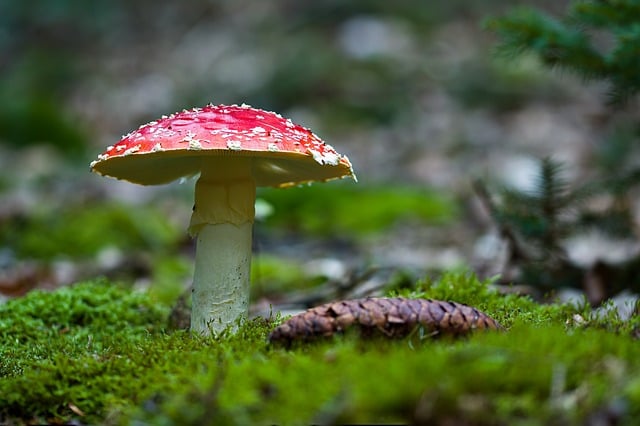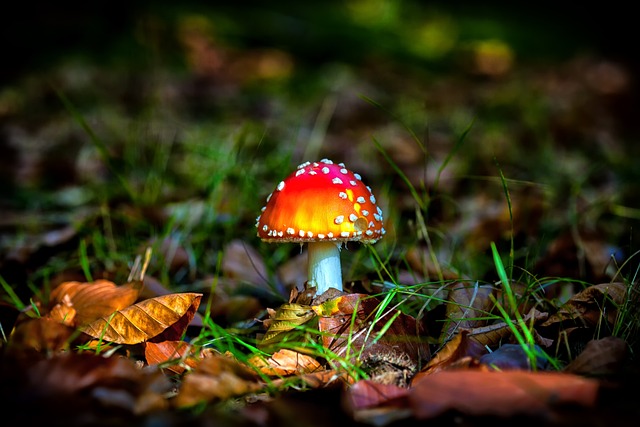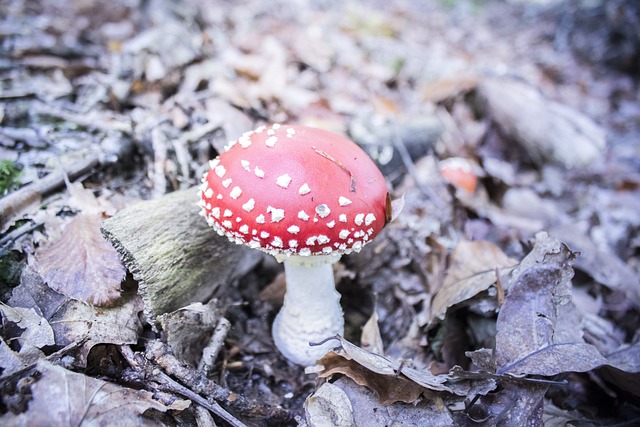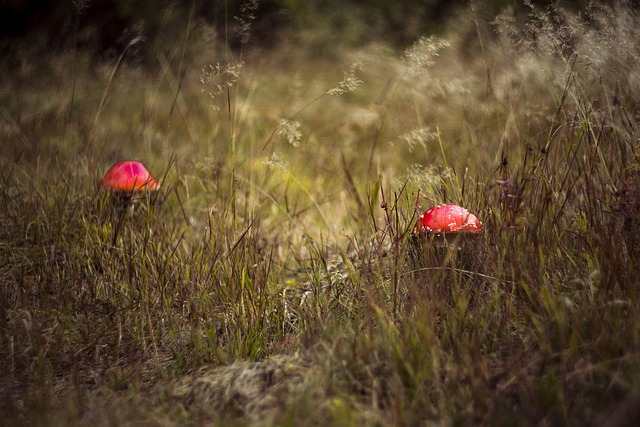Amanita Muscaria, commonly known as Fly Agaric, is a visually distinctive mushroom that contains psychoactive compounds such as ibotenic acid and muscimol. These substances can lead to hallucinogenic effects. It's crucial to understand the legal status of this mushroom in your region before considering any interaction with it. If you choose to explore its properties, ensure that you are well-informed about its effects, do so within a safe and controlled environment, and never alone. Consumption should be approached with caution, respect, and an understanding of the potential risks involved. Remember that Amanita Muscaria is not simply an edible option but a potent psychoactive substance that requires careful consideration and responsible handling under legal and safe conditions. Always prioritize safety and legality when experimenting with or researching this mushroom.
Embark on a delectable journey into the world of gastronomy with our exploration of the Amanita Muscaria Edible, commonly known as the fly agar. This article delves into the rich history, nutritional aspects, and safe culinary practices for incorporating this unique ingredient into your chocolate-inspired creations. From its historical use in cuisines to modern recipes that highlight its earthy flavor, discover how Amanita Muscaria can elevate your dessert game. Join us as we navigate the intersections of tradition, health, and innovation in the realm of culinary delights.
Unveiling the Amanita Muscaria Edible: A Culinary Adventure

The Amanita Muscaria, commonly known as the Fly Agaric, is a species of mushroom with a rich history and an intriguing presence in folklore and mythology. Beyond its storied past, the Amanita Muscaria edible presents a unique culinary adventure for those daring enough to explore its flavor profile. This vibrant mushroom boasts a distinctive red cap with white spots, often depicted in fairy tales and children’s stories, but it is also a gourmet ingredient that can add an exotic touch to various dishes. When prepared correctly, the Amanita Muscaria edible offers a subtle nutty flavor complemented by earthy undertones. Its versatility allows it to be incorporated into a range of cuisines, from savory risottos and stews to sweet desserts like chocolate truffles, where its unique taste can elevate the chocolate base to a new culinary height. It’s important for foragers to identify this mushroom with certainty, as it is poisonous if consumed in its incorrect form. When sourced responsibly and used as an ingredient, the Amanita Muscaria edible becomes a testament to the diversity and richness that fungi can contribute to the gastronomy world. Chefs and home cooks alike are encouraged to experiment with this mushroom, respecting its potency and potential, to create dishes that are both visually stunning and flavorfully remarkable.
Historical Perspectives on Amanita Muscaria in Cuisine

The Amanita Muscaria mushroom, often recognized by its iconic red and white cap, has a long-standing history that intertwines with culinary traditions across various cultures. Historically, this psychoactive fungus has been both revered and feared for its potent effects when consumed. Despite its psychoactive properties, some cultures have found ways to include the Amanita Muscaria in their diets within certain contexts, viewing it as a part of folk medicine or shamanic rituals. In Finland and other parts of Northern Europe, for example, the mushroom has been traditionally used in saunas and as an ingredient in traditional dishes, with the belief that it could ward off evil spirits and promote good health when used appropriately. The edible aspects of Amanita Muscaria have been explored in cuisine, often by indigenous populations who possess intimate knowledge of foraging and food preparation practices to mitigate its psychoactive effects. These historical perspectives highlight the complex relationship between humans and this unique mushroom, where caution, knowledge, and cultural significance play crucial roles in its culinary integration.
The integration of Amanita Muscaria into edible dishes is a testament to the adaptability of human dietary practices and the quest for new flavors and experiences. In Siberia and other regions, recipes have been passed down through generations that include this mushroom, typically in small quantities and often during specific cultural or religious events. The mushroom’s distinct taste, described as a blend of earthy and slightly sweet notes with a hint of bitterness, can complement certain dishes, offering a unique culinary experience. It is important to approach the use of Amanita Muscaria in cooking with respect for both the cultural context and safety considerations, as improper preparation can lead to harmful effects. The historical use of this mushroom in cuisine serves as a reminder of the diversity of edible practices and the importance of preserving the knowledge and traditions associated with it.
Nutritional Profile and Health Benefits of Amanita Muscaria

The Amanita Muscaria, commonly known as the fly agaric, is a species of psychoactive mushroom with a distinctive red cap and white spots. While it has been historically used for its hallucinogenic properties, it’s important to note that consumption should be approached with caution and under legal and safe conditions due to its potent effects. Nutritionally, Amanita Muscaria is a rich source of complex carbohydrates, fiber, protein, and various minerals such as phosphorus and potassium. It also contains B vitamins, including riboflavin, niacin, and pantothenic acid, which are essential for energy production and metabolism regulation within the human body.
Despite its psychoactive compounds, Amanita Muscaria edible has been associated with certain health benefits when consumed responsibly. It contains ibotenic acid and muscimol, which can have neuroprotective properties and may potentially aid in treating conditions like multiple sclerosis by promoting the regeneration of myelin sheaths. Additionally, the mushroom’s active compounds have been studied for their antimicrobial and anti-inflammatory effects, suggesting potential therapeutic uses in combating various bacterial and viral infections, as well as reducing inflammation in the body. However, it is crucial to differentiate between these potential health benefits and the recreational or ritualistic use of the mushroom, which should only be pursued under appropriate guidance and within legal frameworks.
Preparing Amanita Muscaria for Consumption: Methods and Considerations

Amanita Muscaria, commonly known as the fly agaric, is a mushroom with a rich history and a unique culinary profile when prepared correctly. The prospect of incorporating Amanita Muscaria into edible creations has intrigued both culinary enthusiasts and mycophagists alike due to its distinct flavor and psychoactive properties in larger doses. When considering the preparation of Amanita Muscaria for consumption, it is imperative to approach the process with care, as the mushroom contains toxic compounds that can be harmful if not properly processed.
The edible aspect of Amanita Muscaria can be harnessed by removing the cap early in the cooking process and using only the younger, more tender caps, which are believed to contain less of the toxic compound muscimol than the stems and older caps. The preparation method involves a meticulous cleaning, parboiling, and drying process to reduce the toxins before integration into culinary applications. This process is crucial to render the mushroom safe for consumption in certain quantities. Once prepared, Amanita Muscaria can be incorporated into a rich chocolate base, creating a unique and memorable gastronomic experience. The earthy and slightly sweet flavor of the mushroom complements dark chocolate beautifully, offering a dish that is both daring and exquisite. It is essential to follow traditional methods passed down by experienced foragers and chefs when attempting to prepare Amanita Muscaria for edible purposes, ensuring safety and a delightful culinary adventure.
Culinary Integration: Pairing Amanita Muscaria with Complementary Ingredients

The Amanita Muscaria, commonly known as the fly agaric, is a species of mushroom with a rich history of folklore and intrigue. In the realm of culinary integration, this visually striking mushroom can be transformed into an edible delight when paired with complementary ingredients that highlight its unique characteristics. The vibrant red cap and white spots of the Amanita Muscaria make it a distinctive addition to dishes, offering not only visual appeal but also a distinct flavor profile that can elevate a variety of recipes. When incorporating Amanita Muscaria into edible creations, it is essential to focus on flavors that harmonize with its earthy and slightly sweet taste. Chocolate, with its deep and rich base, provides an excellent foundation for this mushroom. The bittersweet notes of dark chocolate complement the mushroom’s subtle nutty undertones, while the creaminess of milk or white chocolate can soften its robust flavor. Additionally, the Amanita Muscaria’s umami qualities are enhanced when paired with ingredients like nuts, citrus zest, and spices such as cinnamon or cardamom. These pairings create a complex and sophisticated culinary experience that is both memorable and delightful to the palate. When preparing Amanita Muscaria for edible use, it is crucial to source them from reliable suppliers or forage responsibly, ensuring their safety for consumption. Proper preparation techniques, such as drying or sautéing, can further bring out the mushroom’s flavors, making it a sought-after ingredient in gourmet kitchens. The Amanita Muscaria edible’s potential in the culinary world is vast, offering adventurous chefs and chocolate artisans a unique opportunity to push the boundaries of traditional flavor combinations and create innovative and exciting treats.
Recipes for Rich Chocolate Delights featuring Amanita Muscaria

For those with a penchant for rich, indulgent chocolate creations, the integration of Amanita Muscaria, commonly known as the fly agaric, into edible formulations can elevate the experience to a psychedelic realm. This iconic mushroom, recognized by its distinctive red cap dotted with white spots, has been a subject of fascination and folklore for centuries. In contemporary culinary alchemy, Amanita Muscaria edibles offer a unique twist to traditional chocolate recipes. When properly prepared and combined with high-quality cocoa, this mushroom can impart an earthy flavor and a visually striking element to your confections. The psychoactive compounds found in Amanita Muscaria, particularly muscimol and ibotenic acid, can intensify the sensory experience of chocolate, creating a delightful and transformative culinary adventure. It’s crucial to handle these mushrooms with care, as they must be prepared specifically to be consumed safely. Chefs and chocolatiers experimenting with Amanita Muscaria edible chocolate creations must adhere to precise preparation methods to ensure the final product is both safe and enjoyable. Whether you’re an experienced forager or a curious confectioner, incorporating Amanita Muscaria into your rich chocolate base can result in a truly unforgettable and visually stunning dessert. Always prioritize safety and legality when sourcing and preparing these mushrooms, and remember that such culinary ventures should be approached with both enthusiasm and caution.
Safety and Responsibility: Understanding the Implications of Consuming Amanita Muscaria

The Amanita Muscaria, commonly known as the Fly Agaric, is a species of mushroom with a long-standing presence in folklore and art, characterized by its distinctive red and white cap. While its vibrant appearance often captures attention, it’s crucial to approach this fungi with caution. Consuming Amanita Muscaria can have profound psychoactive effects due to its ibotenic acid and muscimol content, which can lead to hallucinations and significant changes in perception. The ingestion of these mushrooms should only be considered within legal and controlled settings by individuals well-informed about their effects, with a clear understanding of the potential risks involved. Safety protocols must be strictly followed to minimize harm; this includes dosage control, setting, and company. It’s imperative to recognize that the consumption of Amanita Muscaria is not without significant implications for one’s mental and physical well-being. The legal status of Amanita Muscaria varies by region, and it remains a potent substance best studied in an ethnobotanical or scientific context rather than as a casual edible. Thus, any exploration into the effects of this mushroom should be undertaken with a sense of responsibility and a commitment to safety.
